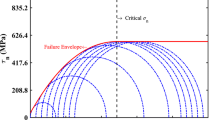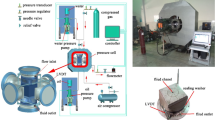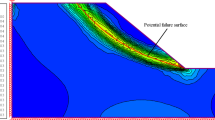Abstract
A non-linear triple shear energy yield criterion for salt rock is presented in this paper. It is the development of the triple shear energy yield criterion, of which the Mohr–Coulomb criterion can be seen as a special case. The main factors affecting the primary strength of salt rock, such as the mean stress and the Lode angle, are considered in the non-linear triple shear energy yield criterion. The non-linear new criterion provides the non-linear change trend of salt strength both in the I 1–J 2 stress space and in the deviatoric plane. Comparative study between the non-linear criterion predictions and experimental results of salt rock shows that the non-linear triple shear energy yield criterion fits quite well with both conventional triaxial test data and the true triaxial test data. For Maha Sarakham salt, the predictive capability of the non-linear triple shear energy yield criterion is clearly better than that of some other criteria used by Sriapai, such as modified Lade criterion, 3-D Hoek, and Brown criterion, Drucker–Prager criterion et al. The availability of the non-linear triple shear energy yield criterion can also be confirmed by comparative analysis between theoretical values and experimental values for non-salt rocks. So the non-linear triple shear energy yield criterion is a general failure criterion for rocks fractured by shear stress.







Similar content being viewed by others
Abbreviations
- c :
-
Cohesion in Mohr–Coulomb criterion
- c 1 :
-
Cohesion in σ 1–σ 3 plane
- D 1, D 2, D 3, D 4, D 5 :
-
Material constants
- G :
-
Shearing modulus of elasticity
- I 1 :
-
First invariant of the stress
- J 2 :
-
Second invariant of deviatoric stress
- k :
-
Limit of the maximal value of shear strain energy on failure plane
- K :
-
Sum of the limit of the maximal value of shear strain energy for an element
- N :
-
Power parameter
- w 1, w 2, w 3 :
-
Maximal value of shear strain energy on the τ 1 plane, on the τ 2 plane, on the τ 3 plane, respectively
- α 1, α 2, α 3 :
-
Angle of the τ 1 plane, the τ 2 plane, the τ 3 plane, respectively
- β :
-
Dimensional constant with the same units as I 1
- σ 1, σ 2, σ 3 :
-
Major, intermediate and minor principal stress, respectively
- σ n1, σ n2, σ n3 :
-
Normal stress acting on the τ 1 plane, on the τ 2 plane, on the τ 3 plane, respectively
- σ m :
-
Mean stress
- τ 1 :
-
Maximum principal shear stress
- τ 2 :
-
Intermediate or minimum principal shear stress
- τ 3 :
-
Intermediate or minimum principal shear stress
- θ :
-
Lode angle
- φ 1, φ 2, φ 3 :
-
Maximal friction angle in σ 1–σ 3 plane, in σ 1–σ 2 plane, in σ 2–σ 3 plane, respectively
- φ :
-
Friction angle in Mohr–Coulomb criterion
References
Chang CD, Haimson B (2012) A failure criterion for rocks based on true triaxial testing. Rock Mech Rock Eng 45:1007–1010
Coulomb CA (1776) Sur une application des regles maximis et minimis a quelques problems de statique, relatives a l’architecture. Acad Sci Paris Mem Math Phys 7:343–382
DeVries KL, Mellegard KD, Callahan GD (2002) Salt damage criterion proof-of-concept research. Topical report RSI-1675/DE-FC26-00NT41026
DeVries KL, Mellegard KD, Callahan GD, Goodman WM (2005) Cavern roof stability for natural gas storage in bedded salt. Topical report RSI-1829/DE-FG26- 02NT41651
Fuenkajorn K, Phueakphum D (2010) Effects of cyclic loading on mechanical properties of Maha Sarakham salt. Eng Geol 112:43–52
Gao YF, Tao ZY (1993) Examination and analysis of true triaxial compression testing of strength criteria of rock. Chin J Geotech Eng 15(4):26–32
Gao H, Zheng YR, Feng XT (2007) Study on energy yield criterion of geomaterials. Chin J Rock Mech Eng 26(12):2437–2443
Haimson BC, Chang C (2000) A new true triaxial cell for testing mechanical properties of rock, and its use to determine rock strength and deformability of Westerly granite. Int J Rock Mech Min Sci 37:285–296
Handin J, Heard HC, Magouirk JN (1967) Effect of the intermediate principal stress on the failure of limestone, dolomite and glass at different temperatures and strain rates. J Geophys Res 72:611–640
Hatzor YH, Heyman EP (1997) Dilation of anisotropic rock salt: evidence from mount sedom diapir. J Geophys Res 102(B7):14853–14868
Hunsche U (1993) Failure behaviour of rock around underground cavities. In: Proceedings of 7th symposium on salt, Kyoto International Conference Hall, vol 1, April 6–9, Kyoto. Elsevier Science Publishers B.V., Amsterdam, pp 59–65
Hunsche U, Albrecht H (1990) Results of true triaxial strength tests on rock salt. Eng Fract Mech 35(4/5):867–877
Lade P, Duncan J (1975) Elasto-plastic stress–strain theory for cohesion less soil. J Geotech Eng Div ASCE 101:1037–1053
Lee H, Haimson B (2011) True triaxial strength, deformability, and brittle failure of granodiorite from the San Andreas Fault Observatory at Depth. Int J Rock Mech Min Sci 48:1199–1207
Liang WG, Yang CH, Zhao YS, Dusseaultc MB, Liu J (2007) Experimental investigation of mechanical properties of bedded salt rock. Int J Rock Mech Min Sci 44:400–411
Liang WG, Zhao YS, Xu SG, Dusseaultc MB (2011) Effect of strain rate on the mechanical properties of salt rock. Int J Rock Mech Min Sci 48:161–167
Liu XY, Ma LJ, Ma SN, Zhang XW, Gao L (2011) Comparative study of four failure criteria for intact bedded rock salt. Int J Rock Mech Min Sci 48:341–346
Ma LJ, Liu XY, Wang MY et al (2013) Experimental investigation of the mechanical properties of rock salt under triaxial cyclic loading. Int J Rock Mech Min Sci 62:34–41
Michelis P (1985) Polyaxial yielding of granular rock. J Eng Mech 111(8):1049–1066
Mogi K (1979) Flow and fracture of rocks under general triaxial compression. In: Proceedings of the fourth international congress on rock mechanics, vol 3. AA Balkema, Montreal, pp 123–30
Oku H, Haimson B, Song S-R (2007) True triaxial strength and deformability of the siltstone overlying the Chelungpu fault (Chi–Chi earthquake), Taiwan. Geophys Res Lett 34:L09306
Ratigan JL, Vogt TJ (1991) A note on the use of precision level surveys to determine subsidence rates. Int J Rock Mech Min Sci 28(4):337–341
Spiers CJ, Peach CJ, Brzesowsky RH et al (1988) Long term rheological and transport properties of dry and wet salt rocks. EUR 11848, University of Utrecht, Utrecht
Sriapai T, Walsri C, Fuenkajorn K (2013) True-triaxial compressive strength of Maha Sarakham salt. Int J Rock Mech Min Sci 61:256–265
Yu MH, Zan YW, Zhao J, Yoshimine M (2002) A unified strength criterion for rock material. Int J Rock Mech Min Sci 39:975–989
Zheng YR, Kong L (2010) Geotechnical plastic mechanics. Architecture and Building Press, Beijing, pp 79–88 (in Chinese)
Acknowledgments
This study was financially supported by the National Nature Science Foundation of China (51225404), Shanxi Nature Science Foundation (2014011044-1), and San-Jin scholar support project, which are gratefully acknowledged.
Author information
Authors and Affiliations
Corresponding author
Rights and permissions
About this article
Cite this article
Hao, T.S., Liang, W.G. A New Improved Failure Criterion for Salt Rock Based on Energy Method. Rock Mech Rock Eng 49, 1721–1731 (2016). https://doi.org/10.1007/s00603-015-0851-6
Received:
Accepted:
Published:
Issue Date:
DOI: https://doi.org/10.1007/s00603-015-0851-6




